This post has not been edited by the GamesBeat staff. Opinions by GamesBeat community writers do not necessarily reflect those of the staff.
 On October 5, 1962, Sean Connery introduced himself to audiences in the UK for the first time as James Bond in Dr. No.
On October 5, 1962, Sean Connery introduced himself to audiences in the UK for the first time as James Bond in Dr. No.
Since then, Bond has gone up against murderous megavillains lounging around titanic secret hideouts and an array of equally wicked minions ranging from the metal-mouthed Jaws to Bambi and Thumper.
There are a lot things I find irresistible about the films, whether it's the thrill of Bond's brilliantly narrow escapes, the bizarre plots the villains dream up, or the lovely women that can also turn the tables on expectations by being as tough as he is.
Bond started out in books written by author Ian Fleming, whose experiences in British Naval Intelligence during WW2 provided a healthy diet for Bond's fiction. As the books later became inspiration for the films, the franchise exploded into everything imaginable. Comics, new novels, and kid's cartoon James Bond Jr. made their way down the pipe from new writers in the decades since Bond boiled Dr. No like a lobster. And then came games as varied as Q's gadgets. From board games in the '60s to video games from the '80s, England's gentleman spy has made a place for himself in living rooms and man caves everywhere.
To help celebrate 50 years of Bond, I thought it would be fun to take a brief look on Bond's digital career. Kicking things off, let's head into the era of big hair bands and arcades: the '80s.
The '80s
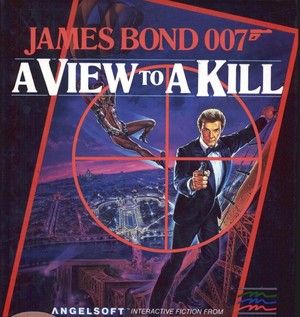 This decade saw two Bonds put in their final bows along with the unexpected, controversial return of Sean Connery.
This decade saw two Bonds put in their final bows along with the unexpected, controversial return of Sean Connery.
Connery briefly reprised his role as Bond in 1983's Never Say Never Again, based off of the same plot as 1965's Thunderball thanks to some convoluted legal wrangling. This eventually led to a "Battle of the Bonds" with the release of Octopussy, starring Connery's replacement, Roger Moore. Depending on who you talk to, Never Say Never Again either is or isn't an official part of the Bond films, though Bond production company Eon Productions has long ignored it in their film count.
As for Roger Moore, he ended his career as the immortal agent in 1985 with A View to a Kill. Timothy Dalton's only two films, The Living Daylights in '87 and License to Kill in 1989, began and ended his brief run as Bond. Only George Lazenby in 1969's On Her Majesty's Secret Service beats him out; that was the only time he played the agent. Six years would pass until Bond returned in 1995's GoldenEye with Pierce Brosnan wearing the tuxedo.
The early Bond games during this period would make the rounds on everything from the Atari 2600 to the Amstrad, the Amiga, and the Commodore 64. Given the technical limitations at the time, most of the titles focused on specific bits and pieces from the actual films, sticking to racing or shooting rather than trying to adapt entire films … much like how films based on Ian Fleming's books often underwent dramatic rewrites for the big screen.
James Bond 007 (1983)
Better known for board games, Parker Brothers also invested in video games like James Bond 007, which arrived just as the console market began to implode. This side-scrolling shooter put you in a super car that jumped over flaming craters like Moon Buggy, shot down enemies in the sky, and bombed them on the ground. It even doubled as a submarine. Luckily, nothing actually attacked it head-on.
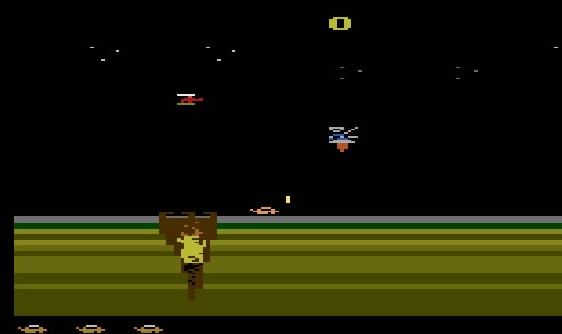
At least the manual was on-hand ot tell the player which movie this was
supposed to be.
The game covered four different movies – Diamonds Are Forever, Moonraker, The Spy Who Loved Me, and For Your Eyes Only. It also had a pretty good rendition of Bond's theme, though the stages only marginally changed the enemies to create the impression that you were actually making progress. More surprising, hardore Bond fans over at MI6 HQ found out the game started out as a movie-tie in for Octopussy before someone quietly recycled it into this.
You can try it out for yourself at 2600 Online. The other versions, like the one for the Atari 5200 seen in its commercial, tended to look at bit better, though that apparently didn't do much for the actual gameplay.
James Bond 007: A View to a Kill (1985)
Mindscape published this PC-only version, a text adventure in the style of Infocom's classics. Though it follows the movie, it took liberties with the plot to stretch it into new situations for the player to solve. You were also on the clock, making it possible to fail the game by not doing things quickly enough. Even mistakes, like typos, would cost you time … and the parser wasn't very forgiving.
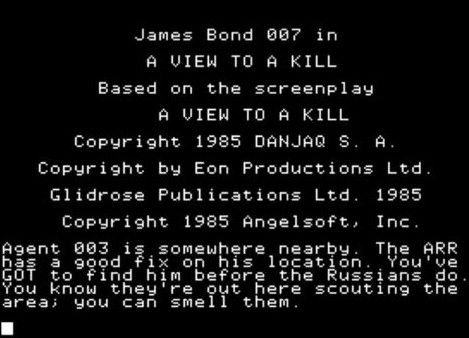
Russian agents are just like grues – except they don't need to hide in the dark to kill you.
A View to a Kill: The Computer Game (1985)
Published by Domark for PCs, this side scroller took place in three different areas. The Mine consisted of a huge, side-scrolling maze of tunnels and caves — think Cave Story. City Hall put you in a series of rooms and made you find Stacy (the Bond girl du jour) before the place burned down. Paris sent you chasing after May Day in your car, doing your best to follow her parachute by racing through the streets thanks to a split screen showing both a top-down and a first-person view.
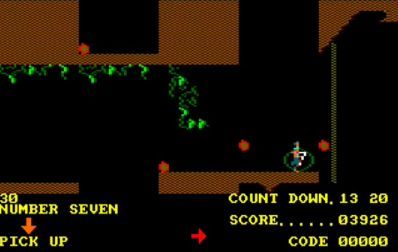
This is a shot of the cave stage where Bond is supposed to find and
disarm the detonator that wil cause an earthquake swallowing
Silicon Valley.
This version had a pretty good rendition of Duran Duran's theme song and an interesting mix of gameplay types. Was it good? The caretakers over at MI6 HQ didn't think so, even for the time. But it still boldly blended different gameplay types into one overarching experience … a design aspect that would prove popular in later years.
007 Car Chase (1985)
If only Bally Midway's Spy Hunter (and several of its platform ports) hadn't come out first, this crude clone could have stood a chance. As Bond, you had a car, possibly even an Aston Martin, armed with machine guns and a smokescreen which you used to blow up enemy vehicles while avoiding the opposition.

Bond's car is the Aston Martin grey in the center.
James Bond 007: Goldfinger (1986)
Another PC-only release like Mindscape's A View to a Kill, and it's another text adventure … this one thinly based on the plot of arguably the best Bond film ever made.
One interesting thing The text was yellow, like gold. It didn't quite follow the entire film in any accurate sense of the word — no duel with Oddjob, or even a setpiece at Fort Knox. It even rewrites the ending which you can read thanks to one fan who recorded it here.
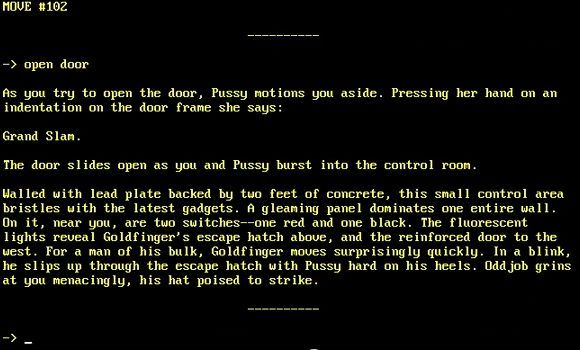
I don't remember this scene from the movie. Then again, the game doesn't really
get to Fort Knox at all other than as part of the epilogue. Oddjob still gets his "shocking" end
though in a different way that from the film.
The Living Daylights (1987)
A side scrolling action-arcade title, The Living Daylights pitted Bond against challenges loosely based on scenes from the movie. It stood out as one of Domark's better Bond games, especially compared to their previous efforts. The only thing missing? The theme song by A-ha to get you pumped.
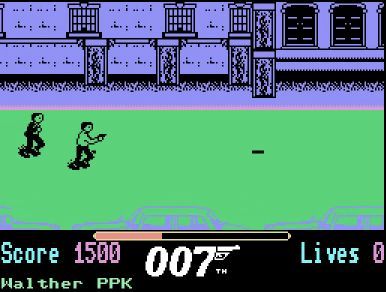
This shot is from the MSX version of the game. It was also released for
other platforms such as the C64, Amstrad, and the ZX Spectrum.
Live and Let Die (1988)
Though released on a number of computer platforms by Domark, it looks really good on the Amiga.
This game resembles Pole Position on water with bullets, rockets, and exploding bad guys. It didn't take you through the entire movie, just a dramatically re-envisioned boat scene. But unlike racing around a bayou to outsmart other guys in boats gunning for an unarmed British agent, developers Elite Systems Ltd. let you stop Mr. Big's bad guys and destroy his heroin shipments with lead rain.
And that's pretty much it. Practice levels and a mission. Not even a bonus round featuring Sheriff J. W. Pepper.

The Amiga version is probably the best looking one out of the bunch.
007: License to Kill (1989)
It's off to seek revenge against Sanchez the Drug Lord in Domark's top-down shooter. Here, Timothy Dalton's Bond angrily flies a helicopter through bullet hell before hitting the ground to personally perforate the bad guys. Each stage is based off of scenes from the movie, such as catching Sanchez' plane with a helicopter and driving gas trucks down a highway while smashing enemies off the road.
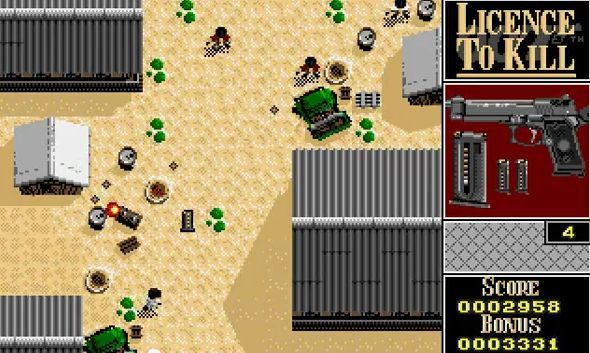
Bond hits back at Sanchez as a one-man-army. Unfortunately, there is no cameo by
Wayne Newton as the cult pope.
The '90s
Pierce Brosnan debuted as Bond in 1995's GoldenEye with Tina Turner's iconic theme song summing up the end of the Cold War. He continued through three more films: Tomorrow Never Dies in 1997, The World is Not Enough in 1999, and 2002's Die Another Day.
As technology improved across consoles and PCs, so did the opportunities for designers to do more with their games. Bond began settling on familiar conventions and design aspects that would define the series going forward, emphasizing pure action.
The Spy Who Loved Me (1990)
The six year lull between A View to a Kill in 1989 and GoldenEye in 1995 didn't stop the games. Bond was still a busy guy.
Domark's next computer title focused on this Roger Moore movie from 1977, pitting him against a shipping magnate with a thirst for creating a new world, a submersable ocean base, and a habit of stealing nuclear subs.
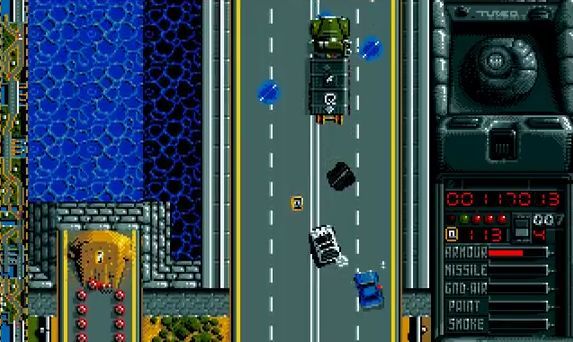
Bond's Lotus dodges bad guys, snags power-ups, and ramps off of dirt piles while racing
along highways littered with oil slicks and evil trucks.
Bond's multi-tasked Lotus careened through dangerous chases leading up to an underwater shoot-em-up with a four-way missile system. You even had to cover the bomb used to break into an enemy control room. And then it was off to save Agent XXX on a jet ski while dodging enemy hovercraft. It didn't seem like a bad action game, though you really had to know the film to have any idea what was going on.
James Bond: The Stealth Affair (1990)
Delphine Software, perhaps better known for Out of this World, created a point 'n click adventure for PCs called Operation Stealth in Europe.For the U.S. market, they tweaked and published it using the Bond license, leading to a number of fairly strange moments.
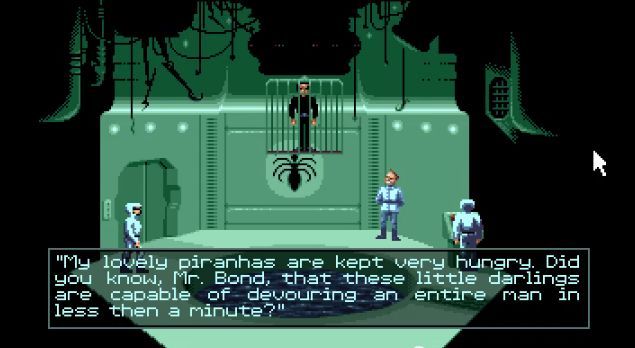
Evil mastermind, secret lair, hungry piranha? Shades of You Only Live Twice and still
a fitting fate for one nosy super spy
The plot revolves around finding and taking back a stolen F-19 stealth plane from a villain who's hidden it in Santa Paragua. Because of the changes, Bond seems to be reporting to the CIA in Washington when the game starts. The Amiga version even had synthesized speech for the text which made everyone sound like the WOPR from Wargames.
Despite shoehorning Bond into this game, the idea that Bond could actually be in an adventure game instead of blowing up everything in a dapper cataclysm proved refreshing, if short lived. But it also became an approach that designer Sid Meier would explore with his own spy-caper, Covert Action.
James Bond Jr. (1992)
Published by THQ and based on the cartoon series of the same name, this showed up on both the NES and SNES. Players took on the role of James Bond Jr., nephew of the famous super spy, whose Saturday morning, kid friendly exploits, pit him against a green-skinned Dr. No and other re-imagined villains making up the forces of S.C.U.M. while balancing schoolwork and student rivalries at Warfield Academy.
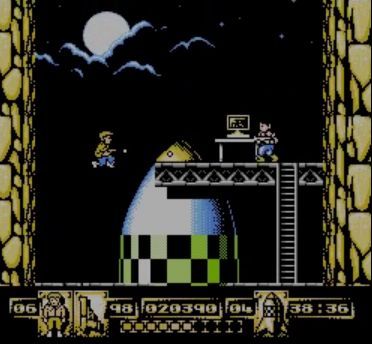
This shot is from the NES version of James Bond Jr. who I'm guessing
isn't putting down bad guys with spitballs.
The NES version sent Bond Jr. on a mission to disarm missiles in side-scrolling, platforming gameplay reminiscent of Capcom's Darkwing Duck. The SNES version played itself off more as a pure action game as Jr. shot, exploded, and jumped his way through each stage to stop S.C.U.M. from recovering ancient artifacts around the world.
James Bond 007: The Duel (1993)
This side-scroller appeared on Sega's Mega Drive and Game Gear and featured Timothy Dalton's face beaming from the title screen before he slipped on the tuxedo. The plot involved a scientist bent on launching killer satellites into space, and he'd cloned supervillains like Live and Let Die's Baron Samedi and Dr. No to help him do it. The game was typically Bond: all action, little exposition.
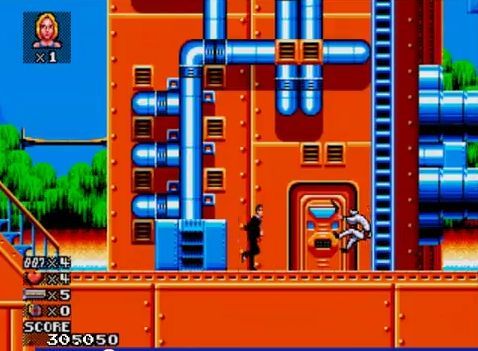
The guy flying back has just been introduced to Bond's bullet-fu.
GoldenEye 007 (1997)
Rare's classic first-person shooter on the N64 redefined the genre on consoles, becoming an iconic yardstick for years to come. It followed the 1995 movie (the first not based on any work by Ian Fleming; GoldenEye is the name of his Haitian estate, but that's where the inspiration ends), in which Bond must stop an old friend from annihilating the world economy with a Cold War weapon.
Rare dramatically expanded movie scenes into massive, action-packed gaming setpieces, complete with smooth controls, stealth sequences, and more than one way to get around each area. It even had local four-way multiplayer, providing endless hours of fun for after you and your friends saved the world. This was Rare at the height of its powers.

Instead of throwing a spare roll over to the guy, Bond decided to end Boris' lack of hygiene
products the old fashioned way.
James Bond 007 (1998)
Nintendo's Gameboy landed another Bond game that tried to defy the stereotypical bullet blitzkrieg that now defined the license.
It wasn't based on any film, but the basics remained the same: save the world by beating down the bad guys. In addition to top-down action, players solved puzzles, collected items, and met people ranging from Bond's boss, M, to his old Goldfinger pal with the razor brimmed hat, Oddjob. The RPG-like elements offered a surprising twist to the normally action-heavy portrayal, much like The Stealth Affair before it.
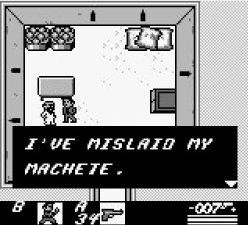
…which is Adventurese meaning "Find it for me."
007: Tomorrow Never Dies (1999)
Bond targeted a media mogul who wanted to escalate international tensions into a shooting match between Britain and China in order to get more mindshare. Not exactly one of the better film plots, but it had its moments … especially when Michelle Yeoh lit up the screen as Bond's opposite number.
As for the game interpretation, this PlayStation third-person shooter drew plenty of action from key movie scenese, inlcuding the explosive jet escape from the film's teaser and, naturally, gunfights through the bad guy's base.

Bond blasts his way through expensive hardware and bad guys with equal measure.
2000 and Beyond
Daniel Craig picked up the role in 2006's brutally refreshing Casino Royale, 2008's Quantum of Solace, and 2012's Skyfall (coming out this month), capping 50 years of clever wit and secret schemes.
Consoles transitioned into the seventh generation, promising new hardware and new methods for designers to play with. But this period saw a rocky mix of titles with EA in the driver's seat and, later, with Activision calling the shots.
007: The World is Not Enough (2000)
Developer Black Ops turned in this tie-in for the Playstation. It followed Bond investigating sabotage at an oil project run by the daughter of an old friend of M's. They threw out the third-person view they used in Tomorrow Never Dies and turned it into a gadget-filled first-person shooter filled with clips from the movie during mission transitions, voice acting, and decent visuals for the time.
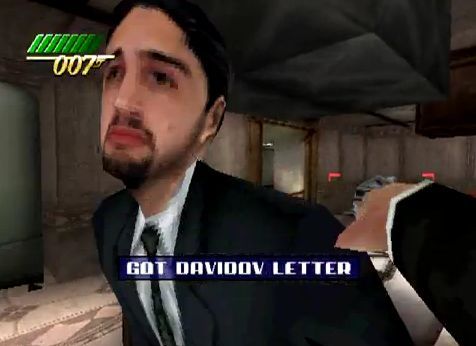
This shot from the PS1 version shows a baddie about to get a mouth full of British knuckles.
Key scenes set up the action while providing plenty of additional opportunities for mayhem It also went heavy on the gadgets … something the N64 version wasn't so keen on. The PS1 version also had fewer missions and no split screen multiplayer.
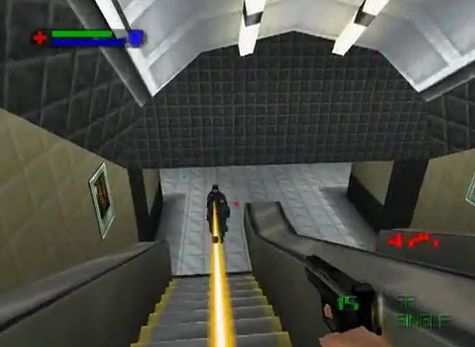
Bond heads over to the subway where he gets to shoot a lot of people in this shot from
the N64 version.
The N64 version came from Eurocom, a developer with and off-and-on involvement in the franchise. They played this one off as a follow up to GoldenEye, reflected in the similar difficulty levels, multiplayer, and run-and-gun action. While you didn't get to use as many of Q's toys, it followed the lessons left behind by GoldeneEye: Keep players' trigger fingers busy.
007: Racing (2000)
Bond's cars have always been important, though the games focused exclusively on driving didn't really show that attention to detail. This PlayStation-only racer from EA focused entirely on taking Bond's armed chariots on a variety of missions. Weak graphics and somewhat dodgy controls undermined anything that might have made it more than a passing stab at the Bond franchise. But it has John Cleese as Q, and for some, that might be all they really need.

Bond doesn't need a garage opener when he has missiles.
007: Agent Under Fire (2001)
Based on an original story involving clones, this one has Pierce Brosnan's Bond shooting and puzzling his way through a first-person shooter with a few gadgets along for the ride. It's got guns and a cell phone that does everything except actually make calls, and it takes you on a worldwide tour of evil from Hong Kong to Switzerland before heading to the South China Sea.
There were also "Bond moments" — bonuses hidden throughout the game that players unlocked by doing something that Bond himself might do, such as shooting an obstacle to fall on enemies or using your gadgets creatively. And of course, there's also the action-packed driving and four-player online mode. Not a bad outing for Bond.
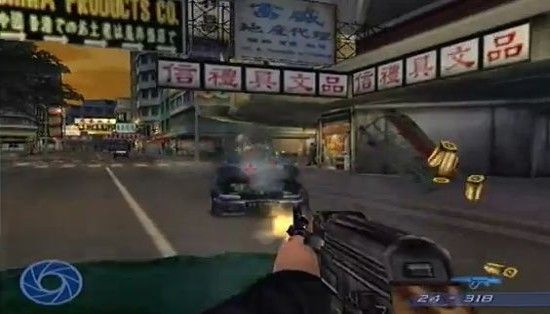
Speeding through the streets of Hong Kong, Bond passes traffic using an AK-47 in this shot
from the PS2 version of the game. It also came out on the Gamecube and the Xbox.
007: Nightfire (2002)
Pierce Brosnan stars again in this FPS pitting him against a supervillain who borrows a few pages from Moonraker's Hugo Drax in an original adventure. Naturally, the only person standing in Raphael Drake's nuke-hording way is Bond, who guns people down through a number of exciting locales, including a showdown in space.
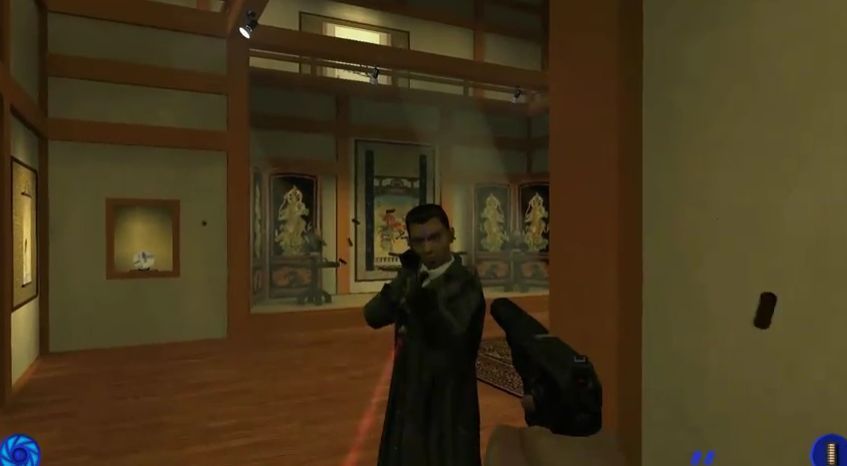
Even though a few bits were shaved from it, Nightfire looked good on the PC.
This plot seemed a bit more coherent than Agent Under Fire, though it didn't quite survive the transition across its various release platforms. Different development houses handled the ports, resulting in some interesting omissions.
The console versions, which Eurocom worked on, had a bit more than the PC version from Gearbox Entertainment. For whatever reason, PC players missed out on the driving elements and even a few of the missions, though more than a few armchair agents easily regard the game on either consoles or PCs as a solid entry in Bond's gaming career.
007: Ice Racer (2002)
This was another mobile-only game based on Die Another Day's car chases across icy roads, ending in a battle against the diamond-studded Zao and his supercar. Just like its next mobile game incarnation six years later, James Bond: Top Agent, it kept the action simple and to the point while providing a tiny slice of Bond on the go.
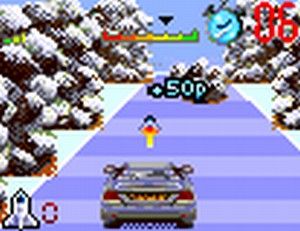
Traffic is never a problem for Bond.
007: Everything or Nothing (2003 for the Gameboy Advance, 2004 for consoles)
A Bond game that so good, it could have passed for another film. EA knocked this game into orbit from the star studded intro and cast to a plot that even referenced a famous Bond villain from the past. An incident involving a platinum mine soon becomes a chase around the world after a former KGB agent played by Willem Dafoe who has designs on resurrecting the Russian superpower under his thumb.
Throw in Jaws, a hefty serving of cinematic flair, and some exciting gameplay both on the road and on foot, and Everything or Nothing provided plenty of fun on the Xbox, Gamecube, and PS2. The Gameboy Advance had also received an isometric version of the game.
Sure, the plot feels about as crazy as some of the previous titles, but the way everything tied together beautifully with sharp presentation and challenging action.
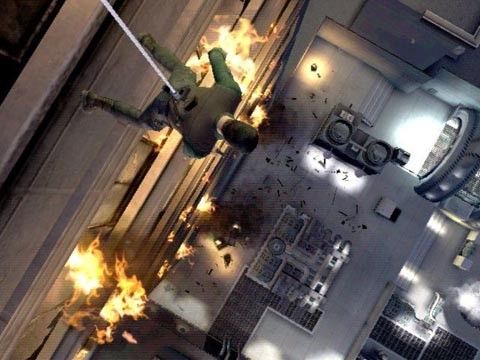
Rappeling down the side of an exploding building, flying through canyons, highway chases,
and shooting your way through everything from ancient ruins to a Cold War super bunker
are all part of the job in one of Bond's best games.
GoldenEye: Rogue Agent (2004)
Unfortunately, the Bond train derailed with a first-person cash in on the GoldenEye name. Casting you as a former MI6 agent whose methods are too brutal for the dapper wetwork required of their employees, you play a gun-for-hire working for the series' supervillains as they try and outwit each other for once instead of Bond.

Dual wielding, because GoldenEye was all about shooting with maximum prejudice.
It really had nothing to do with the film GoldenEye or Rare's FPS classic outside of the name. Mixing iconic villains from different movies in and killing them off didn't sit too well with the Bond faithful, either.
From Russia With Love (2005)
EA quickly returned the next year by adapting one of the best films in the franchise as a third-person shooter. Sadly, they had also forgotten everything that was awesome about the film.
Replace a plot rife with possibilities for secret agent work with the kind of action that would make Shakespeare's Julius Caesar into a first-person knife simulator, then change SPECTRE into OCTOPUS, and you start to see why this came off as a missed opportunity to do something truly great.
The game has a lot that fans of the film never saw, and for good reason. For one thing, I don't remember chaingun thugs on the train. Or the movie ending inside a gigantic base with boss fight against a robotic octopus. Connery provided the voice for his iconic character — a very nice bonus — and the artists captured his likeness perfectly, but this the kind of homage that the series could have done without.
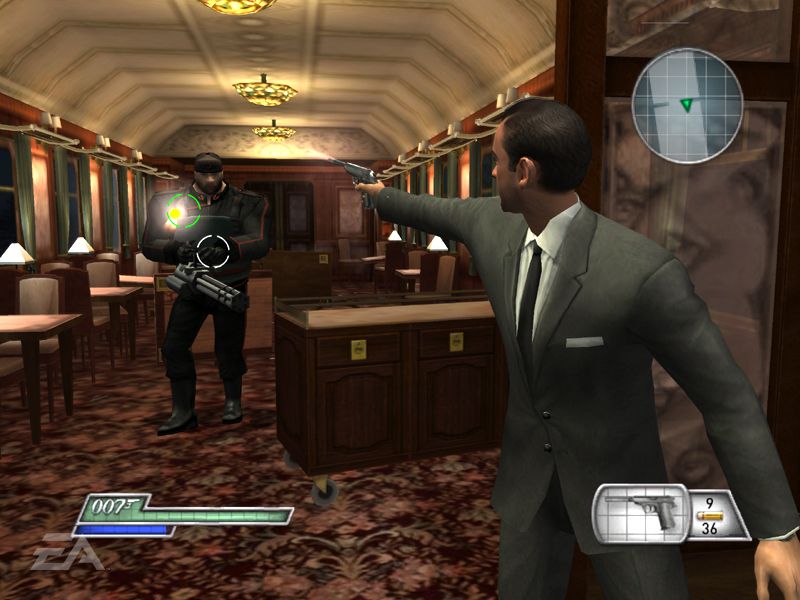
Part of me was happy that an adaptation was made of the film. The other part is still trying
to forget what was done to it.
007: Quantum of Solace (2008)
Activision grabbed the license from EA and handed it off to developer Treyarch (best known for Call of Duty: Black Ops) who crafted this first-person adaptation of Quantum of Solace. Given how much shooting the actual film had, it was a decent fit.
Here, Bond tracks a mysterious organization called Quantum and, like the movie, soon runs afoul of its paid help. The game isn't bad stuff, though it didn't quite expand on anything that GoldenEye didn't amply cover back on the N64. Routine but competent sums it up.

Not a bad tie-in and it was always fun sneaking Craig in to deliver a close-and-personal
beat-down.
James Bond: Top Agent (2008)
A Bond brawler from Sony Online Entertainment. Players faced off against villains, mano-a-mano, in special arenas for apparently no particular reason.
Before fighting them, you can pick the gadgets you want to take into battle and then set up a sequence of moves that automatically play out in the fight in a sort of card-based battle. So if Bond's next move is to punch, the bad guy can avoid getting clocked if a dodge move comes up on their end.
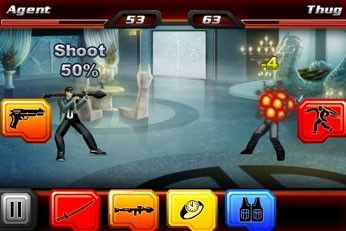
Come on, only a -4 for vaporizing a guy's torso with a rocket?
GoldenEye 007 (2010)
Eurocom's remake of the original game made it feel like a new experience on the Wii, making it one of the best shooters on the console. And if you didn't want to keep waggling at the screen, you could always play the game with a Gamecube controller … a big plus for me.
Entire stages were re-imagined with the visuals that pushed the Wii's hardware. One surprising change was in making Daniel Craig the new face of Bond, replacing Brosnan's likeness to bring the title “up to date.”
Multiplayer allowed players to wear the faces of unlockable favorites such as Oddjob complete with their signature weapons. It tweaked the original story enough to make everything work together in a much bigger and flashier set.
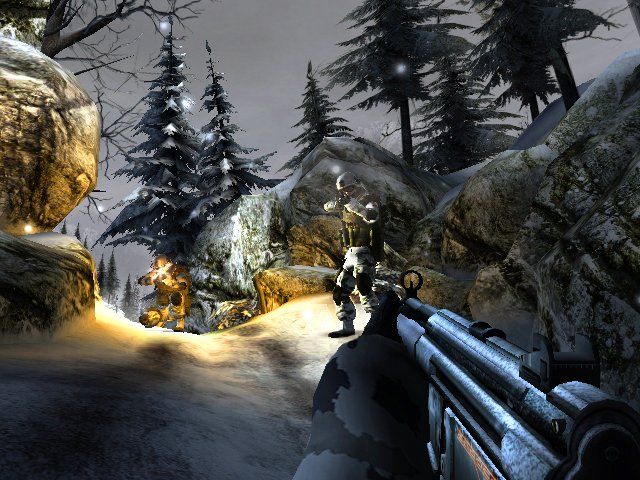
Definitely one of the nicest looking games on the Wii. It was also a lot of fun both off and online.
It would later come to the PS3 and the Xbox 360 in 2011 as GoldenEye 007: Reloaded. Eurocom took advantage of the opportunity to add in single-player challenges and a beefier multiplayer. While it didn't set the bar for console shooters in the way that GoldenEye did in '97, it still provided a fine working vacation for virtual agents.
007: Blood Stone (2010)
This third-person shooter takes place after the events of Quantum of Solace as Bond saves a G-20 summit in Athens from a car bomb and then dives into an investigation into biological weapons that leads him halfway around the world.
So yes, the plot is pretty convoluted, and the action can feel a bit slippery (especially the punishing driving sequences), but it does try to keep the mystery grounded in the films with a mysterious organization pulling the strings on everything. In some ways, it's a side story that just adds more to what the films have set up with Quantum replacing SPECTRE.
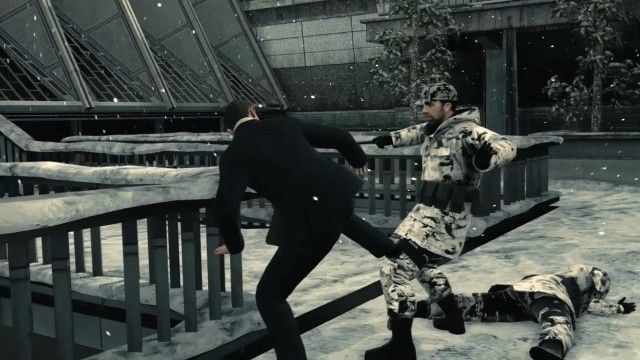
"This suit is worth more than what your knees are being paid."
Final Debriefing
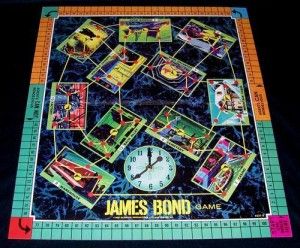 In addition to video games, Bond contributed a number of board games over the decades which you can catch over at Board Game Geek.
In addition to video games, Bond contributed a number of board games over the decades which you can catch over at Board Game Geek.
During the eighties, he even lent his smooth charm to a tabletop RPG complete with modules covering several of the films crammed with stats that finally addressed how tough Oddjob would really be if you rolled a crit at the right time.
007 Legends will also celebrate Bond's 50th in October. Linking together scenes from several iconic films much like Rogue Agent did, it hopes to be an FPS adventure as memorable as the material it borrows from.
Espionage had always been an attractive genre even without Bond to dramatize it. A number of fantastic titles have drawn inspiration from the franchise, such as Monolith's hilarious parody series, No One Lives Forever and more serious fare like Sid Meier's Covert Action in 1990. Activision's 1996 full-motion video title, Spycraft, demonstrated the creativity designers can apply to the genre outside of Bond's shadow. Developer Obsidian Entertainment took a stab at the spy genre with their RPG-angled take, Alpha Protocol, a bold and refreshing gamble that, unfortunately, had clever ideas they never fully capitalized on.
But then, not every Bond game lived up to the legend any more than every movie did. As Bond's meandering gaming history shows, designers and publishers don't always pin down those qualities that truly make James Bond so iconic. Action? Gadgets? Chases? Stealth? All of the above? None of them? To be sure, various combinations proved amazing despite Bond games' obsessive focus on action. The rare attempt to shift away from such cliches isn't always practical … or successful. That said, I wouldn't mind seeing Obsidian's take on Bond. How neat would it be to blend RPG-style dialogue with Bondian zingers.
And just as Bond's adapted to the times on the silver screen, his games frequently made the most of technology and trends of the day. That's why Bond still seems fresh 50 years later. His career has traveled through the Cold War, through detente, and on into the war on terror, touching on each era with humor, smooth wit, and a dangerous glint to his eye. So too he's evolved as gaming's evolved, from 8-bit side-scrollers to 3D shooters.
Bond adapts, and he'll always be ready to engage fans in whatever medium they want.
